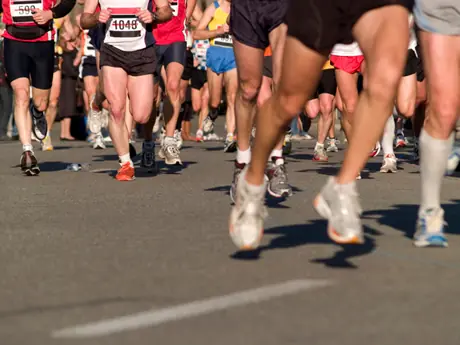Typically the distance athlete will develop a plan based around the building up of as many miles per week as their time or body will allow them in the pursuit of improved performance (Known as LSD - "Long Slow Distance" or as I like to call it "Losing Speed Dramatically!"). There is a simple equation that can determine the results from such a training regime:
LSD = LSR
LSD = long slow distance
LSR = long slow racing!
Once you are capable of completing a specific distance (eg marathon event), the next goal becomes beating your time (indicating a requirement for increased SPEED in your performance).
What basic factors allow you to run faster? Biomechanically it is a combination of increased stride rate and/or stride length. To increase stride rate requires an increase in POWER and an increase in stride length requires an increase in STRENGTH.
Regular distance running will initially aid in the base development of these two factors but typically the improvement is minor resulting in a plateauing in your race performance.
Definitions:
To have a better understanding of why these training elements should be incorporated into your training program, it is useful to have a better understanding of how each element effects running performance.
Speed The ability to quickly move a limb, or quickly move the body from one point to another. Both of these definitions relate to distance running because one thing the distance runner needs to be able to do is to develop what is known as a speed reserve.
Speed reserve is where the athlete develops a high running speed (you probably won't be challenging Marion Jones but you will be faster than you were) so that when you are running an endurance event where your speed is somewhat less than maximal, you are able to expend less energy travelling at that speed. Once the body knows how to run fast, at slower speeds, there is less effort required resulting in reduced energy expenditure which will assist in saving energy for the latter stages of any event.
Strength The ability to coordinate and contract muscle fibres to overcome a resistance.
Each time an athlete takes a step, strength is required in the following phases:
- Resisting collapse each time the foot hits the ground. Eccentric forces (the forces that occur at each foot contact) are very high in distance running and the stronger the athlete in the appropriate areas, the less collapse at contact, the quicker off the ground and the faster they can move into the second phase of the stride.
- Pushoff takes place at the end of each contact. The stronger the pushoff the longer the stride meaning the athlete is covering more ground with each step therefore needing less steps to complete a distance (less energy expended).
- Strength through the athlete's mid-torso will also assist in maintaining efficient running technique throughout the race.
Power The ability to perform a movement with strength at speed. Power is the combination of speed and strength but needs to be trained regularly to get the best coordination between these two attributes.
- 1
- of
- 2
Get ACTIVE on the Go


Couch to 5K®
The best way to get new runners off the couch and across the finish line of their first 5K.
Available for iOS | Android







Discuss This Article